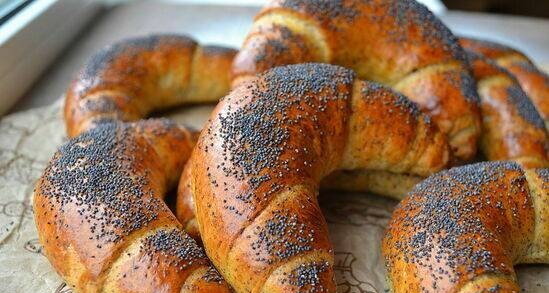|
Miranda

I wanted to buy a gas burner for culinary purposes for a long time. I love watching all kinds of cooking videos on youtube, and there the chefs use the burner a lot. Of course I also wanted to!
In addition, there is at least one recipe in which you cannot do without a gas burner - Creme brulee. On our forum there is a wonderful recipe for this creamy dessert.
Creamy dessert with caramel crust "Creme brulee" (Irina F)
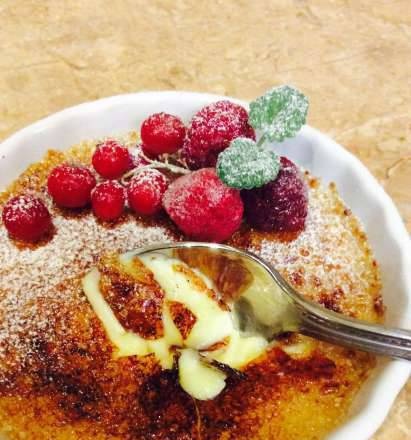
A gas burner can be used to cook a steak - instead of frying in a pan, it is enough to burn it well with a burner, and only then send it to the oven. Or, when steak is cooked using the sousvid method, then at the end the meat is seared with a burner to give it a golden brown crust (you can type Sous Vide Blowtorch on YouTube and see how different chefs do it).
Also, with the help of a burner, you can burn the fish, giving it the desired crust. Or you can burn the chicken, which is especially important if the stove at home is electric. You can scorch vegetables for a smoky flavor. Or bacon wrapped in various rolls.
With a burner, you can peel tomatoes or bell peppers using a burner instead of blanching. The scorched skin can be easily removed. You can melt cheese, scorch bread. There is a lot of things for which fantasy is enough.
And, of course, the burner can be used in pastry - beautifully tint meringue, caramelize anything (cream or fruit). In short, a thing in the kitchen will come in handy.
And, although a cooking gas burner (or caramelizer) is not the most complicated gadget, there was still a problem of choice. But I will tell you about the choice at the very end. The fact is that the choice is the choice, but everything was decided by the holiday discount and the accumulated points in the store. Having decided to compare my pros and cons in practice, I, without hesitation, bought this burner.
The box looks like this.
There is all information about the burner in Russian.




Let's open the box.
Everything is packed tightly, especially I was worried about 4 molds.

Let's get out of the box - two small boxes, a burner packed in bubble-walled cellophane, and separate documents.
There is no gas. Manufacturers do not pack with gas for safety reasons during transportation. Gas must be purchased separately.

The boxes contain molds. They sit tightly there, cardboard between them.

Molds look like ceramic, not porcelain. Because their bottom is rough, not glazed. With a similar bottom, I have molds from a well-known store of the same price. They say that non-glazed ceramics cannot be washed in dishwashers.

In size, they turned out to be the smallest molds that I have.
In the photo - a large mold from a store of the same price, then an average standard mold, and on the extreme right - from the kit. The molds are small, I have seen these in different video recipes, where they show all the ingredients in their own bowl, and in such small ones they show sugar, salt, spices or vegetable oil or sauces.
The dimensions of the molds from the kit are the upper inner diameter of 7.2 cm, the lower inner diameter of 5.7 cm, the height of 4 cm.

Documents are a guarantee for 12 months. There is a number on the warranty card (closed in the photo). And the instruction is in Russian.

The burner itself, instructions in different languages (except Russian), and an adapter for charging (lies on the instructions) were in the pimpled cellophane.

Below there is a hole through which you need to fill the burner.

Which I did. I bought gas beforehand. The manufacturer advises buying butane gas cans. But I have 70% butane, 30% propane, and that's okay too. For the first time in my life I was filling, so at first some part of the gas was on my hands and clothes. We must learn somehow. According to the instructions, you need to press 3-4 times for 3-4 seconds. Only the last time it came out well, the first time everything hissed and passed by. But here the fault is only on me.
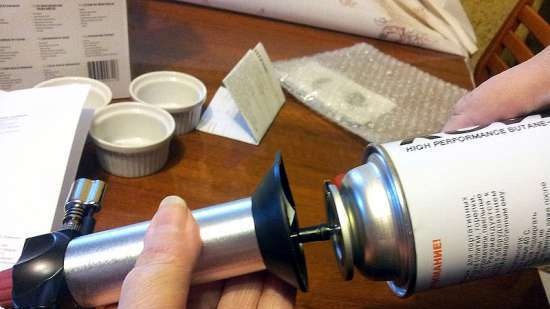
This gas burner has three controls.
1. Red cap at the top - clockwise it shuts off the gas, counterclockwise it opens. During filling and storage, the cap must be turned clockwise as far as it will go.
2. Red button on the back - pressing it produces a spark from the piezoelectric element. The red cap needs to be turned halfway counterclockwise, the gas will go, press the button and the fire will light up. The amount of fire can be adjusted with the cap.
3. The iron thing I'm pointing at is the air regulator. The size of the fire also depends on this. Or, I would even say, the thickness of the flame. And the red cap is for the length of the flame. If the regulator is screwed closer to the burner body, the flame will be thinner. If closer to the gas outlet, then thicker.
The manufacturer advises against twisting this iron piece while the fire is burning. And although I twisted, I still support this advice. Because it's very hot 

Feels like I can say that when the iron piece is as close as possible to the gas outlet, and the red cap is also at the maximum, then the fire is very big. It even turns yellow, like a burning match. In other positions, the fire is blue.
The strength, length and thickness of the flame can be used differently for different tasks.
***
We urgently need to set something on fire for good culinary purposes.
I made the creme brulee in advance. The surface was sprinkled with sugar.
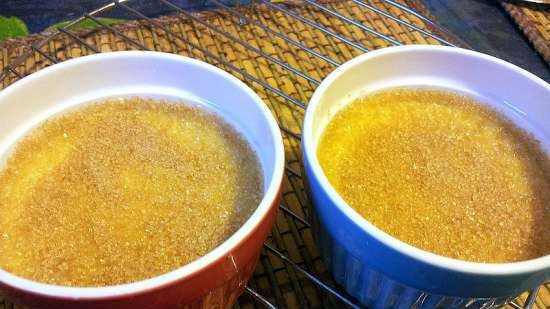
And she burned the sugar with a burner.
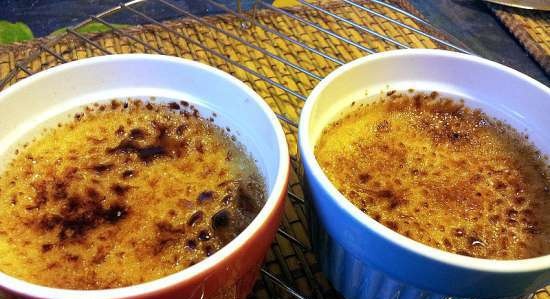
Well, and then urgently broke the caramel crust. Delicious!
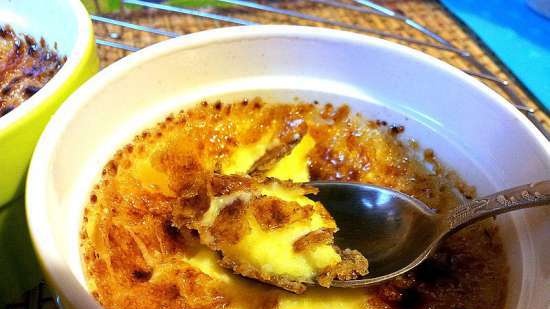
I also decided to burn a piece of bread.
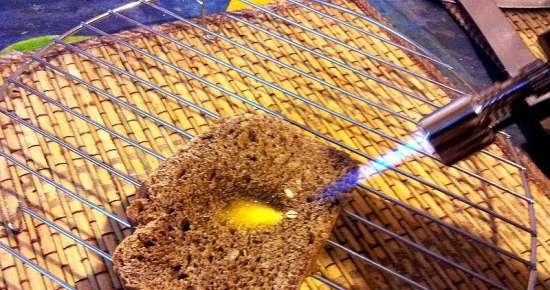
The smeared butter immediately began to melt.
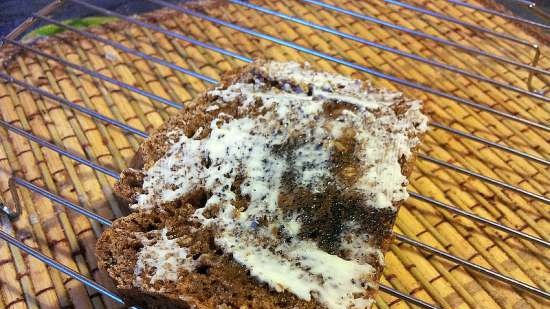
And then she burned the cheese.
It's not cheese that burns, it's good, not counterfeit  This is the same fire as on bread, i.e. on contact with food, it turns yellow. This is the same fire as on bread, i.e. on contact with food, it turns yellow.

This sandwich doesn't look like a hot sandwich at all.
The bread was as if I had held it over a fire - it smelled like smoke, the crust was hot and crunched, but the bread was not hot inside. And the cheese melted differently than if I was making a hot sandwich in the microwave or oven, or how it melts on a pizza. And also, as if held over a fire.
TOTAL:
- the burner is comfortable, fits well in the hand, and generally pretty
- the molds are also cute, they will come in handy on the farm, but as for me, they are too small for creme brulee
- the fire can be adjusted for the desired task. But it still seems to me that a steak cannot be fried with such a burner, although I will have to try it somehow. But, it will definitely suit to singe chicken, vegetables, meringue. The burner did an excellent job with crème brulee.
- you need to fill your hand to fill
***
Now the promised pangs of choice.
There are only two types of burners - similar to mine, and a nozzle for a gas cylinder.
The main difference is size.
This is what the nozzle looks like on a gas cylinder.

Now compare what my burner looks like against the background of the same gas cylinder.
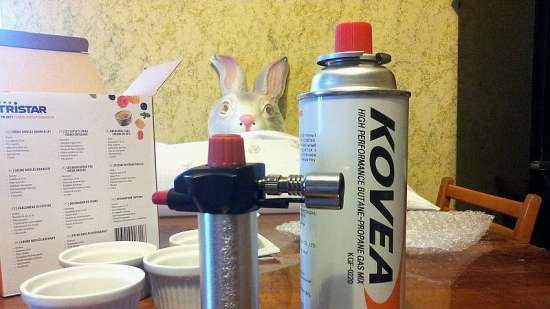
And there are even more brutal options for attachments and / or cylinders.
 
And yet, these two types differ in the strength of the flame.
The nozzle has a flame five, if not ten times more active than such small burners.
It was clear that a small burner would not cope with frying meat. Opalite - yes, fry - doubtful. But do I need to fry meat with a burner? Also, I was a little afraid of such a big fire. And that a large gas cylinder will be in your hand and suddenly explode? Because I'm a bit of a coward 
I watched a lot of videos, where they clearly showed that the same sugar on creme brulee is turned into a caramel crust with a burner-attachment in a matter of seconds, and the burner needs to be driven over sugar for a longer time. So I was tormented by a choice - a nozzle or a burner.
What would I advise when choosing?
One of the main conditions for a burner is piezo ignition.
But whether it will be a small burner, or a nozzle - the choice is yours.
To do this, you need to answer yourself the following questions:
- what exactly do I need a burner for? Roasting meat or for rare small processes?
- won't you be afraid to hold a gas cylinder in your hand?
- are there small children at home who can reach for a potentially dangerous toy?
***
And separately I would like to say about the choice of where to buy.
If you google "culinary gas burner" or "caramelizer" or "culinary flamber" (or flumber, but it's still from the French flambé, flamber), then you will most often find the burner. Single or complete with molds. And at a price from 1.5 to 3.5 thousand.
And if you just google a "gas burner" or, even, a "gas cutter", then you do not end up in culinary stores, but in sports, tourist or repair shops, where the burner (which can be called a lighter), that the nozzle on the cylinder will cost 500 -700 RUB It can be even cheaper, but then it is definitely without piezo-ignition.
So it is with the purchase of a balloon. In cigarette shops and markets, I saw cylinders for 250-500 rubles. But I bought it in a sports store for 90 rubles. And there is also for 60-70 rubles. The necessary cylinders are called - collet gas cylinder.
Good luck with your culinary experiments!
Forum thread about burners: Cooking felt (gas burner)
|




























